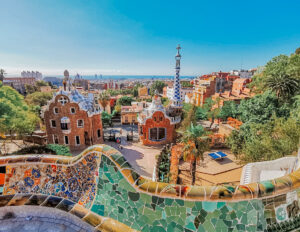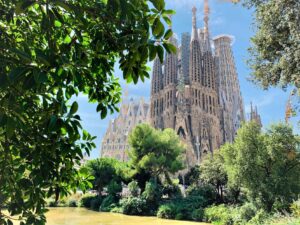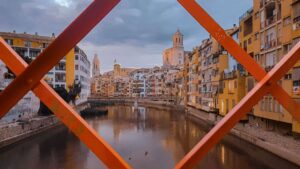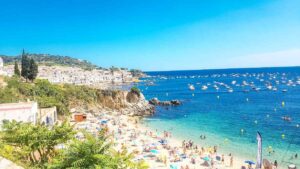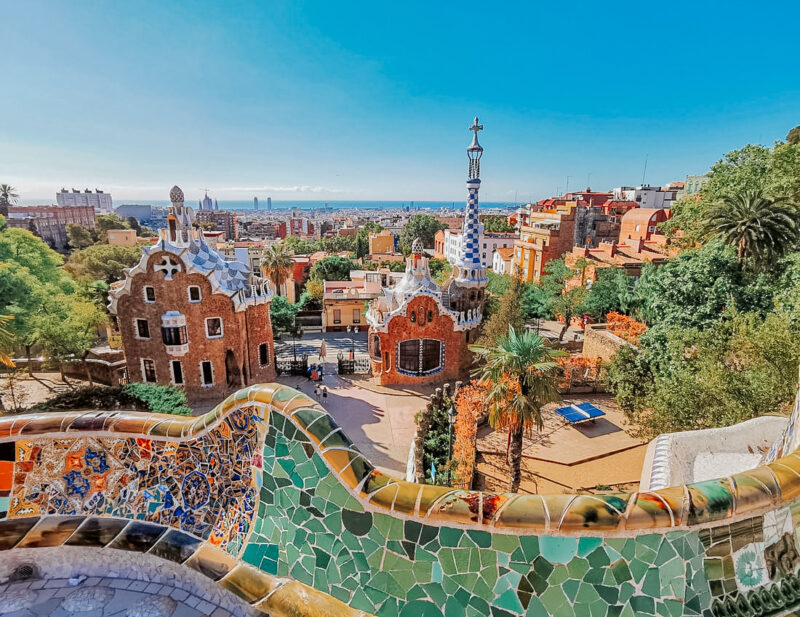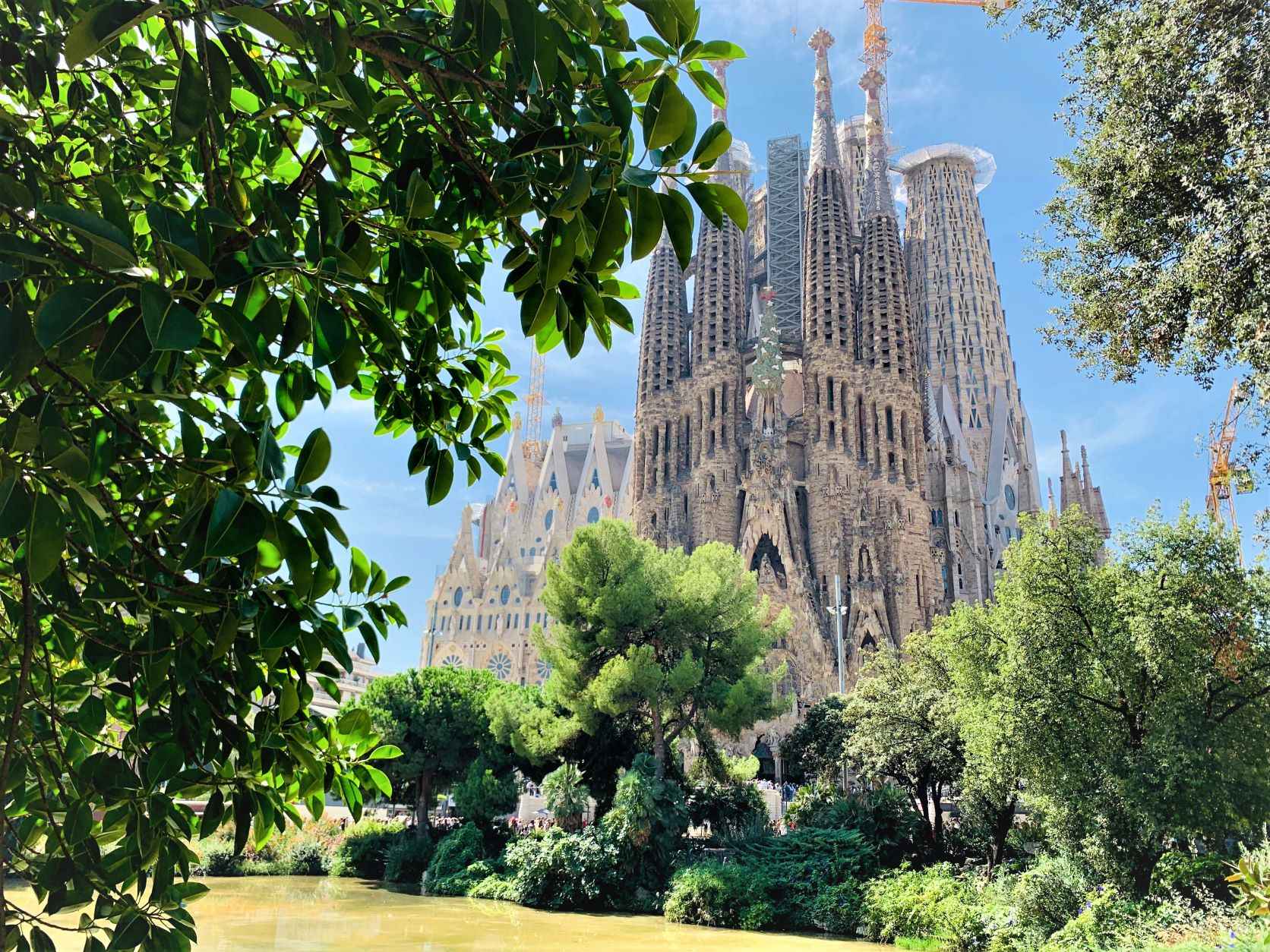South of Spain Road Trip: The Ultimate Southern Spain Itinerary
A South of Spain road trip is undeniably one of the best road trips to take through Spain and Europe. This Southern Spain itinerary includes some of the most iconic cities in the world. You can explore cultural sites, and historic buildings or bask in the sun on some of the most beautiful beaches in the world.
Spain is one of the most popular countries to visit in the world. The country sees some of the highest tourist numbers in Europe each year. One of the most popular regions in Spain is the Andalucía region in the South of Spain. Southern Spain has a laid-back culture and puts on great weather for most of the year.
This South of Spain itinerary will show you exactly why this road trip should be on everyone’s bucket list. Andalucía is filled with great art, charming streets, delicious food, and a diverse landscape filled with beaches and mountains. It has so much to offer no matter what type of holiday you are looking for.
Planning a trip to Southern Spain can be tricky. There’s an overwhelming number of places to visit in Andalucía, it’s tough to narrow down exactly where to go. I’ve been fortunate enough to spend a few months traveling through this region which is why I’ve put together this 10-day South of Spain itinerary and road trip guide that gives you an insight into the top places to visit in this region. It’s one of my favorite parts of Spain as it’s just pure magic!
Disclaimer: Please note that some of the links in the article below are affiliate links, and at no additional cost to you, we earn a commission if you make a purchase. All opinions are our own and we thank you for supporting the businesses which support us.
Table of Contents
ToggleWhat is Andalucía like?
The history and culture of Andalucía is very unique to the rest of the country. If you are looking for the ultimate Southern Spain itinerary, this guide highlights some of the best places to visit in the South of Spain. With delicious food, over 100 blue flag beaches, and amazing culture, you’ll want to immerse yourself in this fine country.
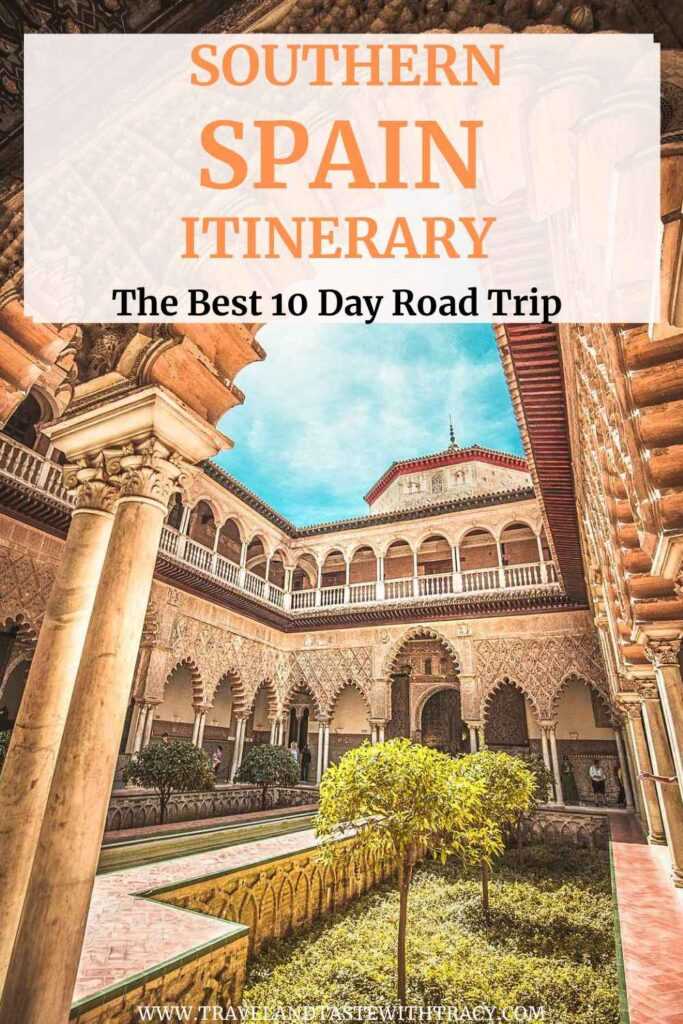
When to Visit Southern Spain
The great thing about Southern Spain is that it receives over 300 days of sunshine per year making it a popular tourist destination for northern Europeans looking to escape the cold during their winter months.
The best time to visit Southern Spain is in the spring and fall months of April to June and September to November. These times of the year see lighter crowds and have pleasant temperatures for you to enjoy your time exploring the region.
Spring is a great time to visit right before the crowds hit this part of the region. And it’s also warm enough to hit the beach. If crowds and hot temperatures aren’t you’re thing, try to avoid visiting during the peak summer months of June to August when temperatures can get as high as 40 deg Celcius and above.
Quite honestly, there’s no bad time to visit Southern Spain. But keep in mind the Andalusian summers can get very hot. While the temperature may be perfect for beach holidays, it’s far less pleasant when you are road-tripping. Since you’ll be making your way through towns, cities as well as beaches, I’d highly recommend traveling during Spring or Fall. No matter when you visit this amazing country, you won’t be disappointed. We visited Southern Spain in September and October and the weather was just perfect for us. The temperatures were pleasant and it was warm enough to still swim during the day and explore the streets at night. I carried a lightweight jacket during the nights in October as it had a mild chill in the air.
How Many Days do you need for the South of Spain road trip?
You could easily spend a month or more exploring the Andalusian region. But at the same time, if you live somewhere in Europe, you could book a long weekend trip to the Costa del Sol or Seville. The options are endless.
But if you are coming from further away, I’d recommend a minimum you need at least 10 days to see the top highlights in Southern Spain. Of course, if you have more time I’d recommend spending 2 weeks in this region. This will easily allow you to cover all the major tourist areas as well as visit some of the off-beaten attractions in Southern Spain.
Getting Around Southern Spain
While hiring a car to get around this part of Spain is the most convenient way and provides utmost flexibility, if you are not comfortable driving or don’t want to drive, then all the stops on this route are easily accessible by bus and train. Within each city, you can walk and use public transport to get around to most of the major tourist attractions.
Personally, for us having a car worked amazingly well. It provided us with the flexibility and convenience for exploring some of those off-beaten paths. If you are confident enough to drive through this region, I’d highly recommend hiring a car as the South of Spain itinerary is specifically designed as a road trip.
If you do plan to drive, consider basing yourself in larger cities like Seville, Malaga, or Granada and taking day trips to some of the other cities and towns.
Tips for Traveling through Southern Spain
- Avoid traveling during peak summer when temperatures are extreme and crowds are at their highest.
- Buy your tickets to the Alhambra and Seville Alcázar well in advance of your arrival. The Alhambra books out months in advance so make sure you have these tickets booked as soon as you start planning your Southern Spain holiday. You definitely won’t be able to buy tickets on the day as they limit the number of daily visitors. You can book on their official site or here. I suggest getting the one that includes the Nasrid Palaces as this is the most intricate and beautiful structure on the grounds.
- Rent a car if you feel comfortable driving in Spain. This itinerary is catered more toward a road trip. Having a car gives you the flexibility and convenience of traveling through this region.
Southern Spain Itinerary Overview
- Day 1: Granada
- Day 2: The Alhambra
- Day 3: Nerja and Malaga
- Day 4: Historic Centre of Malaga and Malagueta Beach
- Day 5: Day trip to Marbella
- Day 6: Ronda, Setenil de Las Bodegas and Cadiz
- Day 7: Cadiz
- Day 8: Jerez de la Frontera and Seville
- Day 9: Seville
- Day 10: Cordoba
South of Spain Road Trip: The Ultimate Southern Spain Itinerary
With a region as large and diverse as Andalucía, it can be challenging to find the best route and shortlist places to visit. This South of Spain Itinerary is based on 10 glorious days in this region. Spain is well known for three top cities in the Andalusian region: Seville, Cordoba, and Granada. This itinerary also includes areas of the Costa del Sol such as Malaga and Marbella because they have so much to offer.
If you’re wondering where to start when planning a road trip through the South of Spain, you’ve come to the right place. There are a few different routes you can take through this part of Spain. As we were traveling through Spain for months, the route we decided to take was Granada – Seville – Cordoba. These are the three main cities in the region and are must-visit places in Southern Spain. We’ll of course look at exploring a few of the smaller towns in the region.
If you have only 10 days for your Southern Spain road trip, I’d suggest you do the following route. While this route starts in Granada, you can always tweak this itinerary if you are flying into Malaga or Seville. That’s the great thing about this road trip itinerary, it covers all the main places for you to visit in Southern Spain while giving you the flexibility to adjust the itinerary to suit your travel needs.
Day 1 – Granada
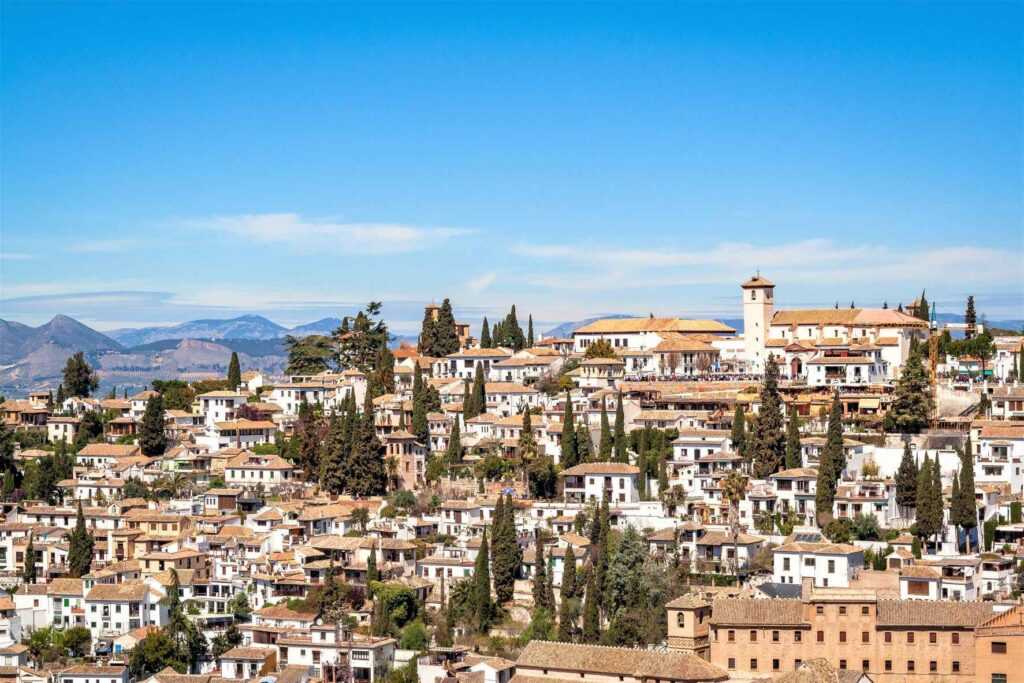
On day 1 of your Southern Spain itinerary, you’ll arrive in Granada. Spend some time settling in, exploring the spectacular city of Granada, and familiarising yourself with the local neighborhoods. Granada is located at the foothills of the highest mountain in Spain. It’s one of the most popular cities in Spain so plan well in advance to make your trip here seamless.
Granada celebrates its Moorish past and has preserved its architecture from that era. The city is still so heavily influenced by its Moorish roots. You’ll find the smell of hookahs, incense, and plenty of restaurants that serve you delicious food.
The city is well known for its famous Alhambra, the most renowned palace and fortress that fills Granada with tourists from all over the world. You’ll visit this fortress on day 2. Granada has so many neighborhoods, each unique in its own way. The city is walkable and is filled with history, a fortress, and a beautiful cathedral among many other attractions.
Here are some of the top things to do in Granada:
- Visit the Alhambra and the Nasrid Places.
- Walk through the Albaicin, Spain’s old Morrish quarter
- Stroll through the main city center and visit Granada Cathedral, Royal Chapel, and Alcaiceria
- Make your way to San Nicolas View Point overlooking the Alhambra and the Albaicin. Visit at sunset for some amazing views.
Assuming you arrive in the morning, we recommend starting your day in the historic center and exploring the picturesque Albaicin (Arab Quarter). You can climb up to the Mirador San Nicholas for spectacular views of the Alhambra with the Sierra Nevada Mountain range as the backdrop. Finally, enjoy some delicious tapas.
I remember finding a lovely Middle-Eastern restaurant on one of the streets and having a delicious meal while sipping on some mint tea. It was a funny feeling of being in Spain while still feeling like I was in a different country.
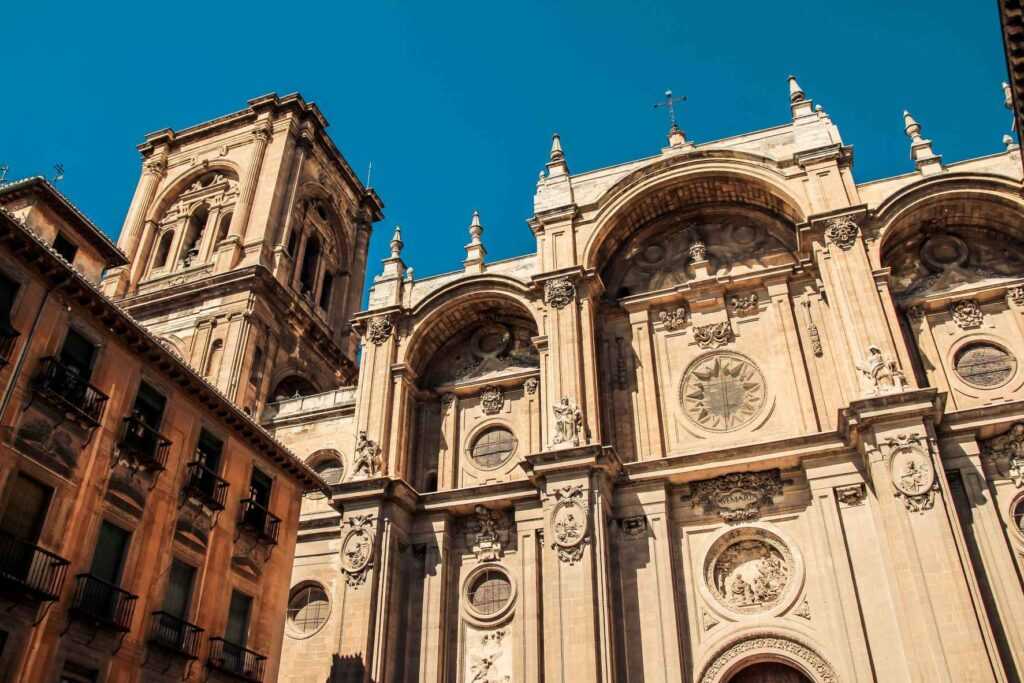
After lunch, you can make your way to the main city center and visit Granada cathedral, Spain’s second-largest cathedral. Next head to the Royal Chapel and then check out Alcaiceria, a narrow-laned market where you can find spices, and other goods.
Lose yourself in the city’s narrow streets, which are full of an Arab-Spanish charm. Finally, finish up your day at one of Granada’s local tapas bars. In this region of Spain, you can get a free tapa for every drink you order. If that’s not attractive enough I don’t know what is!
Note: If you have only one day in Granada, choose to see the Alhambra. It’s an impressive building that is considered one of the most popular and important sites in Spain. We recommend leaving your rental car at your accommodation and exploring Granada on foot or using public transport within the city itself. The city is large and the streets are narrow so finding a parking space within the city center can be challenging.
Day 2 – The Alhambra
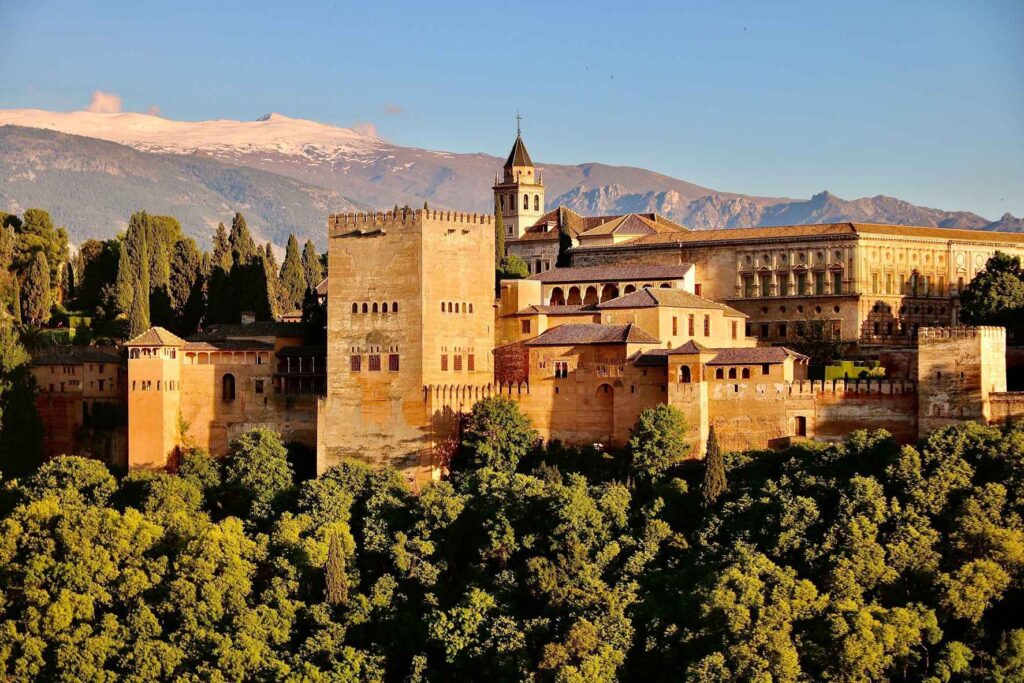
Today you’ll be exploring the incredible Alhambra fortress, castle, and gardens. It’s hard to put into words the beauty the Alhambra exudes, the Moorish fortress that will take your breath away. If there is one place you shouldn’t miss in Spain, let it be the Alhambra. It’s undeniably one of the top tourist attractions in Spain and one of the highlights of this Andalucía road trip itinerary.
The Alhambra is divided into three main parts, the Nasrid Palaces, the Alcazaba, and the Generalife Gardens. The complex includes several towers, buildings, courtyards, fountains, and a mosque. But it’s the beautiful tiled ceilings, the elegant arches, intricate stone carvings, and the serene courtyards of the Nasrid Palace that are a pleasant surprise for the eyes. Make sure your tickets include entry into all three parts. You can choose to book a guided tour or book the option of a self-guided audio tour. We did the self-guided audio tour and it was perfect for us.
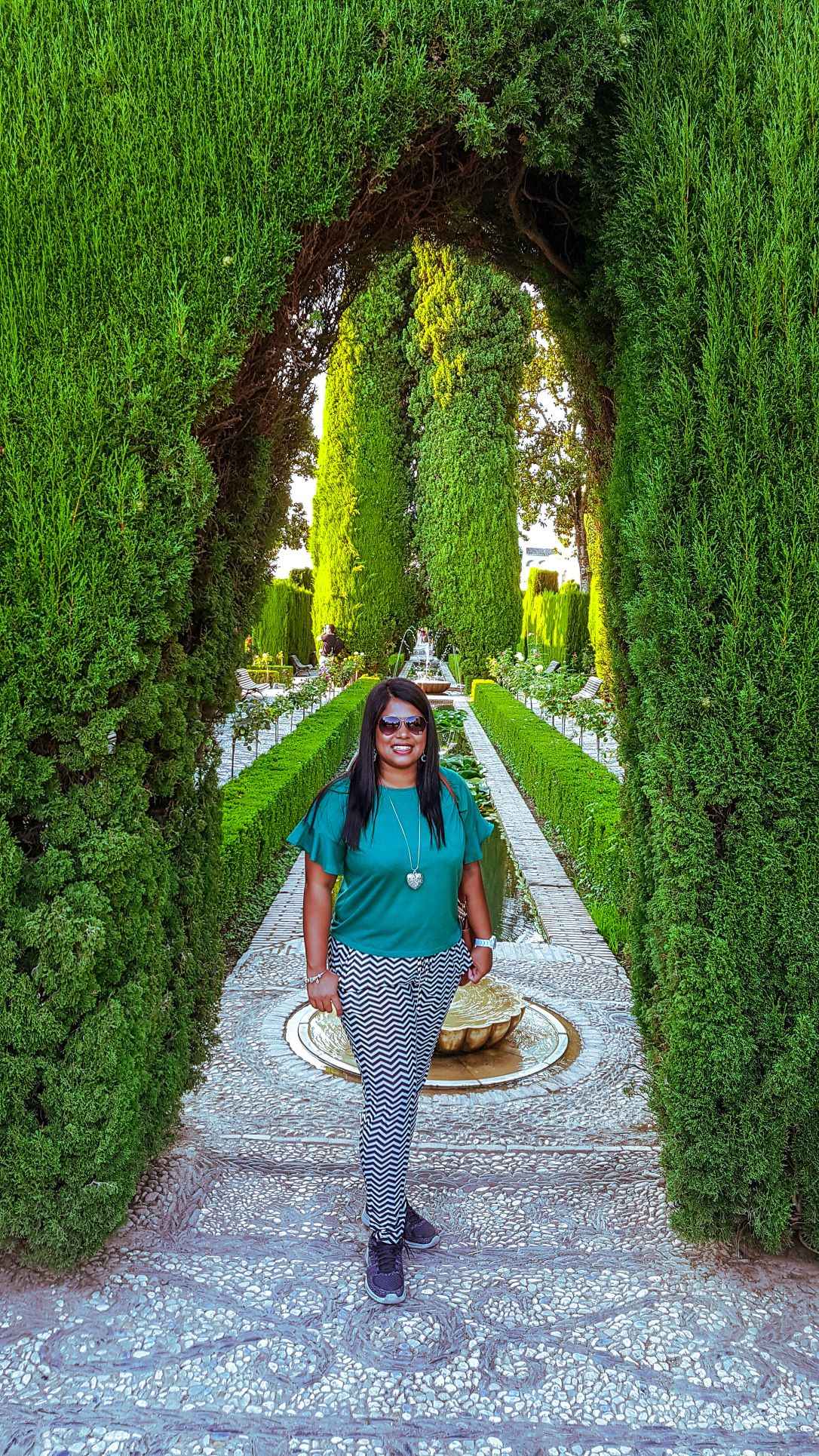
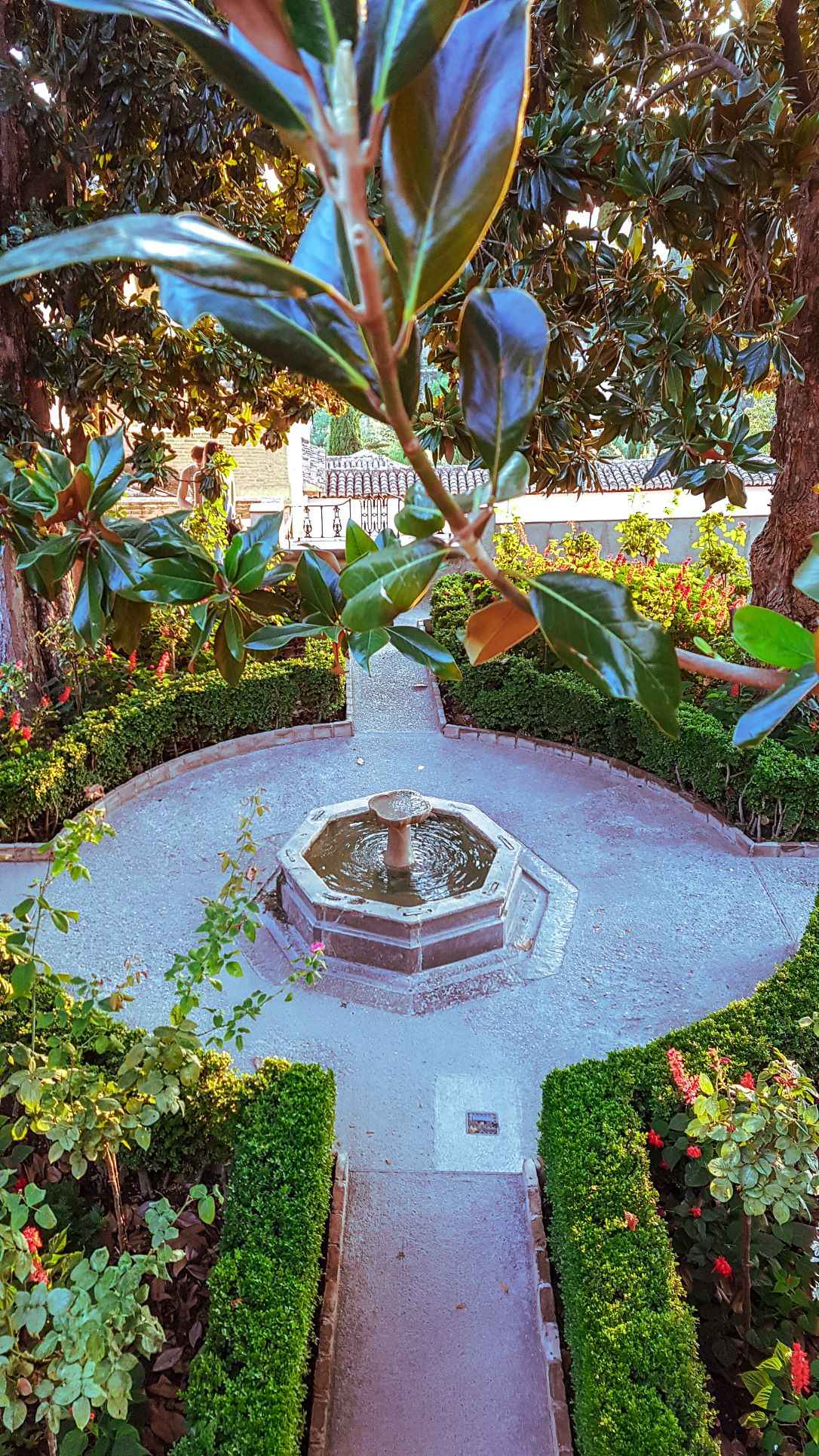
The Generalife gardens provide a peaceful atmosphere and offer beautiful views of the Alhambra. The Alhambra is truly the crown jewel of Southern Spain and a top attraction that should be on everyone’s bucket list
Set aside at least half a day for the Alhambra. Best to get tickets for the morning. Then you can get lunch when you’re finished and spend the rest of the day getting lost in the charming streets of Granada and soaking up the atmosphere in this magical city. Finish off with a delicious meal in the city center.
Tip: I will say this many times, book your tickets to the Alhambra well in advance. Tickets to the Alhambra can sell out months in advance so be sure to book as soon as you know you are heading to Granada to avoid disappointment.
Day 3 – Nerja and Malaga
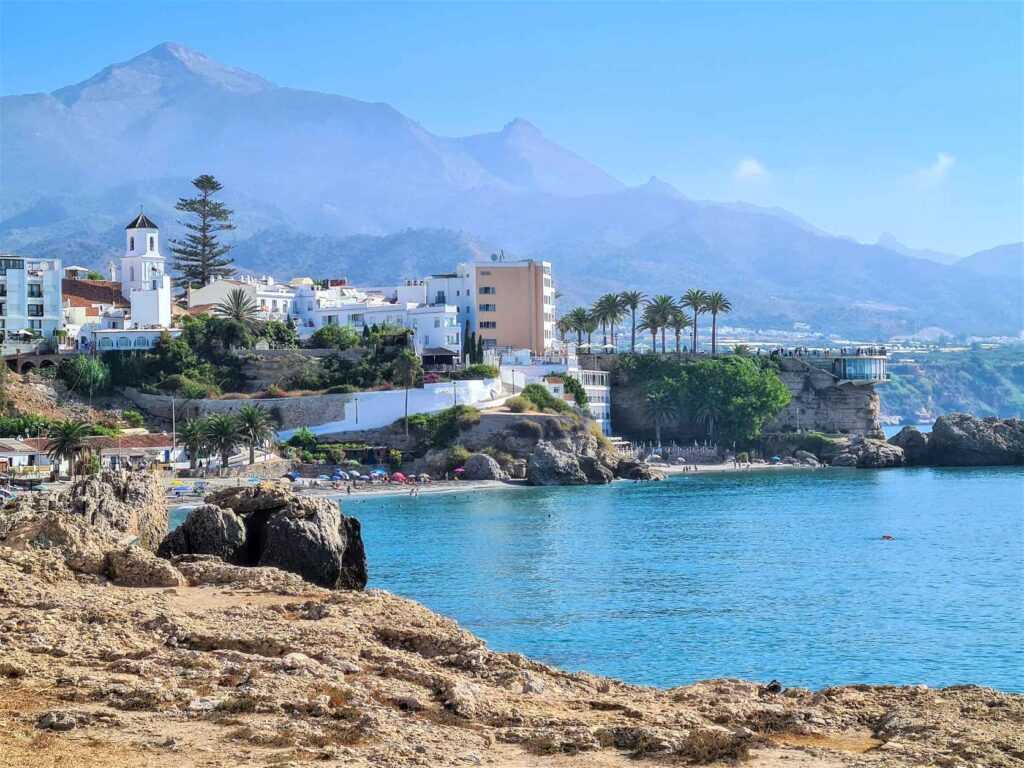
On day 3 of your Southern Spain itinerary, you’ll start your day early and make your way to Nerja in the Costa del Sol. The journey from Granada takes about an hour. Just make sure you start early enough so you can make the most of your day in Nerja after which you will head to Malaga.
Nerja is a beautiful white town that is famous for its turquoise beaches and caves. It provides a very different feel to Granada, swapping culture and history for the coast. Spend a couple of hours exploring this picturesque town. Start by visiting the caves. Going to see Nerja Caves can be a great family excursion. A regular visit (without a guide) lasts about 45 minutes. There are audio guides available to learn more about the history of the caves. Wear warm clothes and comfortable shoes to navigate the many steps at the caves.
Then head to Balcon de Europa in town, a viewpoint that overlooks the sea and mountains. Balcon de Europa is located at the heart of the town center. It’s a great location to explore some of the shops and indulge in some local Andalusian cuisine.
Alternatively, spend a couple of hours relaxing at one of the beautiful beaches in Nerja. Maro Beach is one of the more popular beaches in the area with crystal clear waters and glistening sands.
Note: Parking in Nerja isn’t easy as it gets very busy, especially during the summer season. Street parking in some places is free but can be tough to find a spot. The Municipal Underground Car Park which is situated close to Balcon de Europa is the perfect parking spot if you want to stay central. However, the price of parking your car can be a hefty amount (~ 22 euros/ day).
Malaga
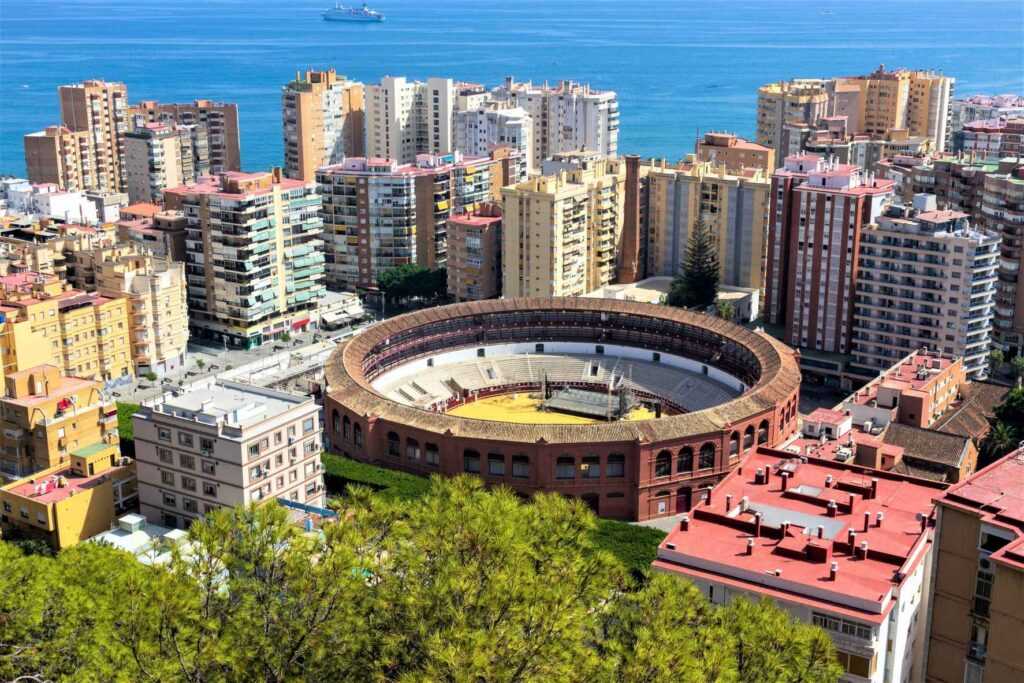
Once you are done exploring the white town of Nerja, make your way to Malaga which is only about 45 minutes away. Malaga is a historic port and the biggest city in the Costa del Sol so it’s a great place to base yourself for a couple of days and make day trips from here.
What I love about this city is it offers a mix of beach, culture, and history. The best way to explore Málaga is to wander around the streets and explore its historic architecture. Make sure to leave some time to relax on the famous Malaga beach, Malagueta.
Three nights should be enough to see the best of Málaga and make a day trip to the nearby town of Marbella. There are several great things to see in Malaga. When you arrive in Malaga settle in and then head to the historic center. Because you’ve had a long day already, we’ll keep evening 1 nice and relaxing.
Grab a snack if you need to and make your way to the Malaga cathedral. The cathedral is not to be missed as it is one of the most famous attractions in Malaga. You can also go to the top of the 87-meter-high tower and enjoy a 360° scenic view. Spend the rest of the evening wandering the historic center if you aren’t too tired or even sit back at one of the restaurants near the beach.
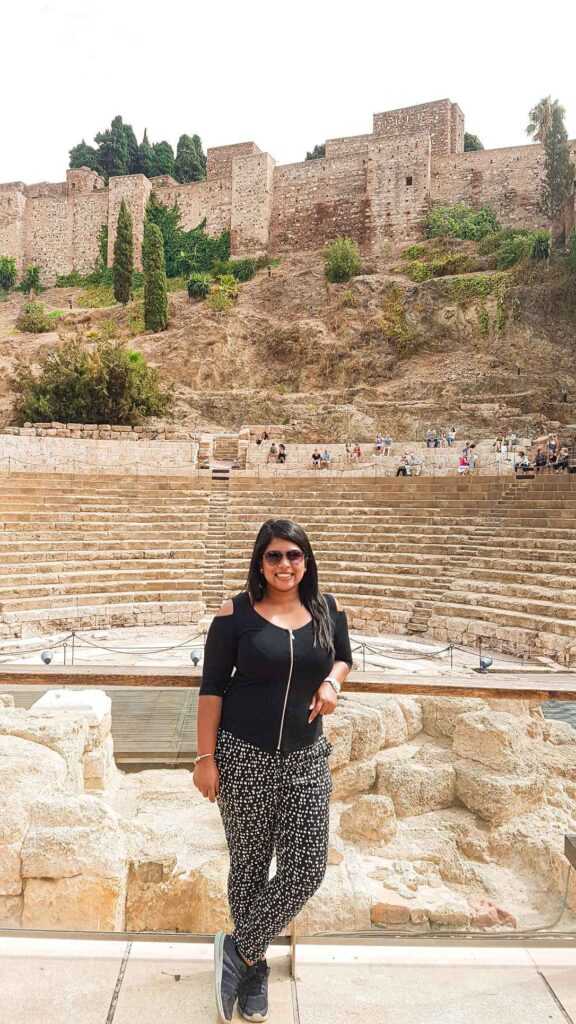
Here are some of the top attractions in Malaga:
- The Alcazaba, an 11th-century palace
- Gibralfaro Castle, to enjoy the magnificent view over the city
- The Roman Theatre of Malaga, the oldest monument in the city
- Malaga Cathedral
- Mercado Central de Atarazanas
- Malagueta Beach
- Pablo Picasso Museum and the Picasso Birthplace Museum
You can book one of these tours while you are in the city.
Day 4 – Historic Centre of Malaga and Malagueta Beach
Start the day off early by visiting the Gibralfaro castle and the Moorish Alcazaba fortress. They’re both set on a hilltop with incredible city views. If you don’t feel like a hike to the top, take the 35 bus which takes you to the top of the hill.
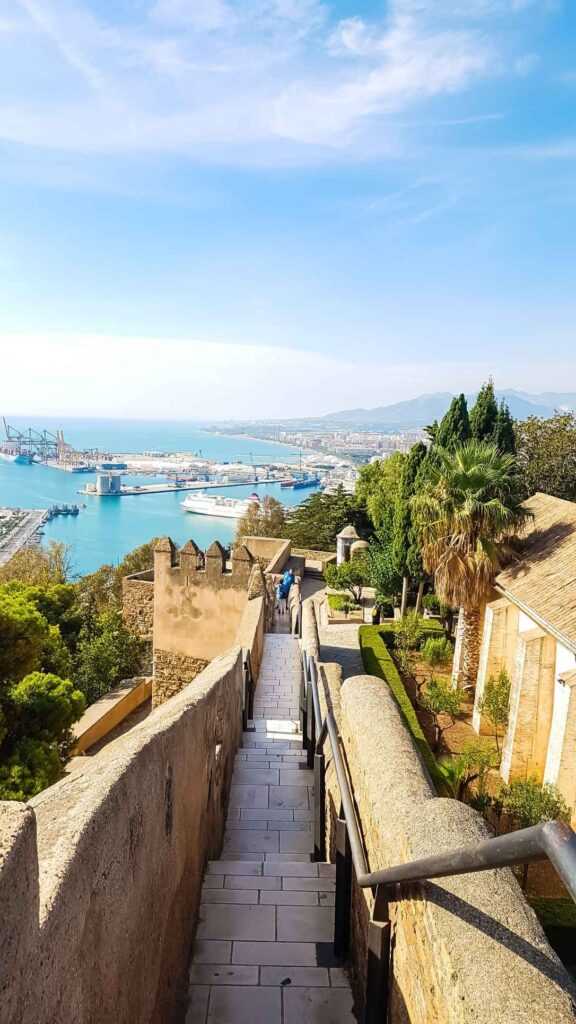
Gibralfaro offers the most scenic views over Malaga city and the sea. Walk downhill on your return to the magnificent Alcazaba of Malaga. This 1,000-year-old citadel is an impressive fortification that once stood to protect the city. You can pay a few euros to enter, but if you want an in-depth background to the history then a guided tour will give you all the insights into the Alcazaba as well as the adjacent Roman theater that dates back to the 1st century BC. This is one of the oldest monuments in the city.
Next head to the Atarazanas market (Mercado Central de Atarazanas). Not only is the building itself well worth your time, but you’ll find an array of mouth-watering delicious and local foods here. It’s the perfect place to grab a refreshing drink and a quick bite. Maybe even pick up a few local goodies for your time at the beach later in the day.
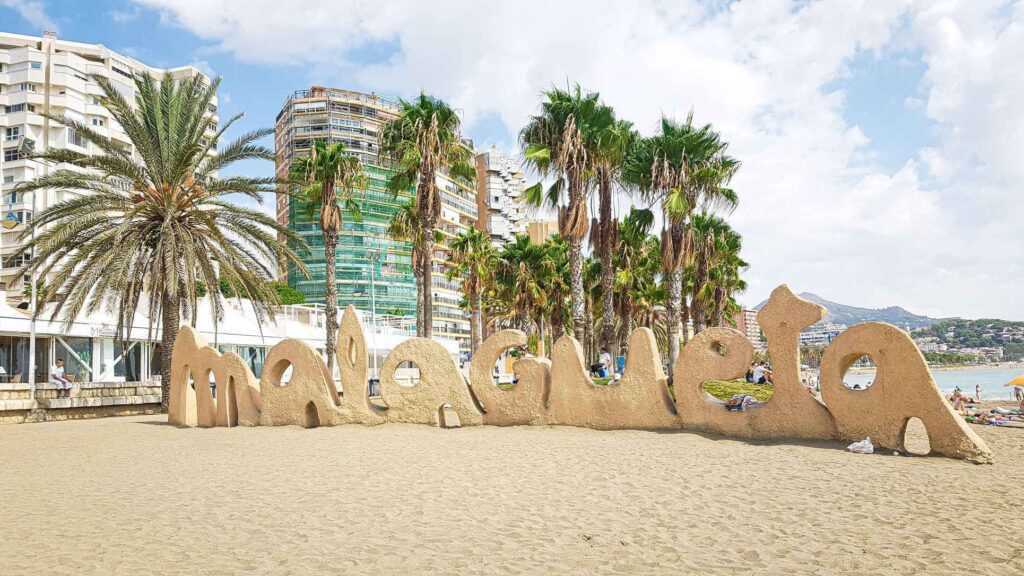
Spend the rest of the day at the famous Malagueta beach. This may be your only chance to relax on a beach during your Southern Spain road trip. So, make the most of it.
The Costa del Sol is known for its stunning beaches so take a walk down the promenade or rent a bike and ride along the picturesque promenade on the Mediterranean Sea. Enjoy some delicious Espetos (skewers of grilled sardines) that can be easily found at one of the restaurants situated at the beach.
Day 5 – Day trip to Marbella
You’ll start your day nice and early and visit the seaside resort city of Marbella, located about an hour’s drive from Malaga. You can spend the morning exploring this trendy town.
Marbella is a bit chicer and trendier as compared to Malaga. You’ll find plenty of luxury shops, bars, and clubs along with 20km of beach to relax all day long. It’s known to be the party central area of the Costa del Sol.
Explore the old town, window shop at Puerto Banus, or simply sunbathe at one of Marbella’s beaches. Either way, you’re in for a treat when you get to this little seaside town.
Grab some lunch before you make your way back to Malaga for a laid-back evening. Visit the Picasso Museum or go shopping in Calle Larios.
Lastly, set sail on Málaga Bay to get amazing views of the city center. Sit back on the deck with a glass of bubbles while you take in the beautiful sunset in the Costa del Sol. It’s simply magical and one of the more popular things to do in Malaga. Just make sure you book your tickets well in advance. It’s the perfect way to end your time in the Costa del Sol.
Beaches close to Malaga
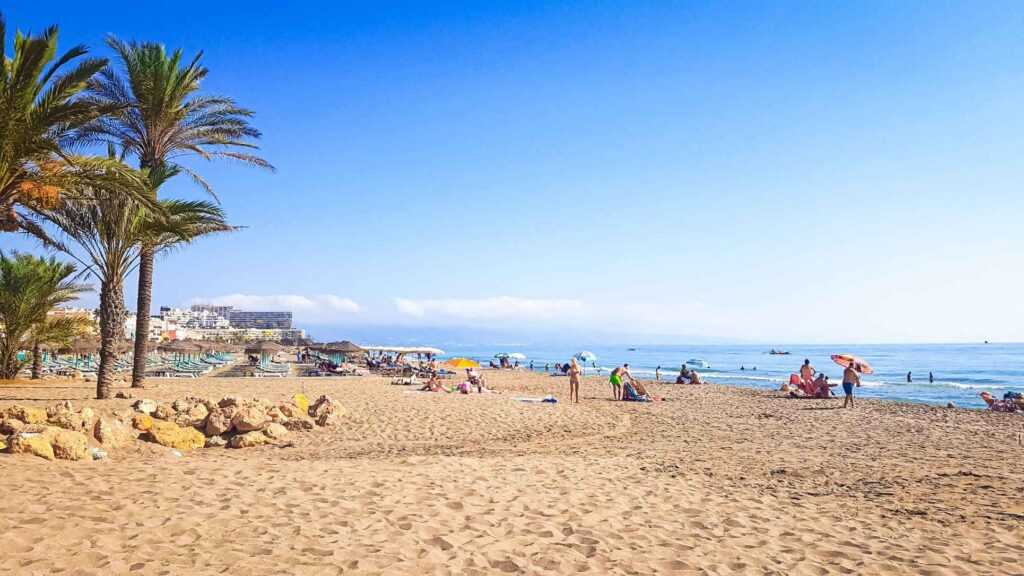
Given you are in the Costa del Sol with some of the most pristine beaches, it would be a shame to miss out on visiting a few of these beaches.
- Malagueta beach: Convenient as it’s located next to the port, it’s the closest to the city center.
- Pedregalejo beach: This beach is located a bit East of Malagueta.
- La Caleta beach, very crowded during summertime
- El Palo beach: A family-friendly beach located in the fishermen’s neighborhood
- La Misericordia beach: One of the more popular beaches in Malaga
- San Andrés beach: has grassy areas and a playground
Malaga Museums
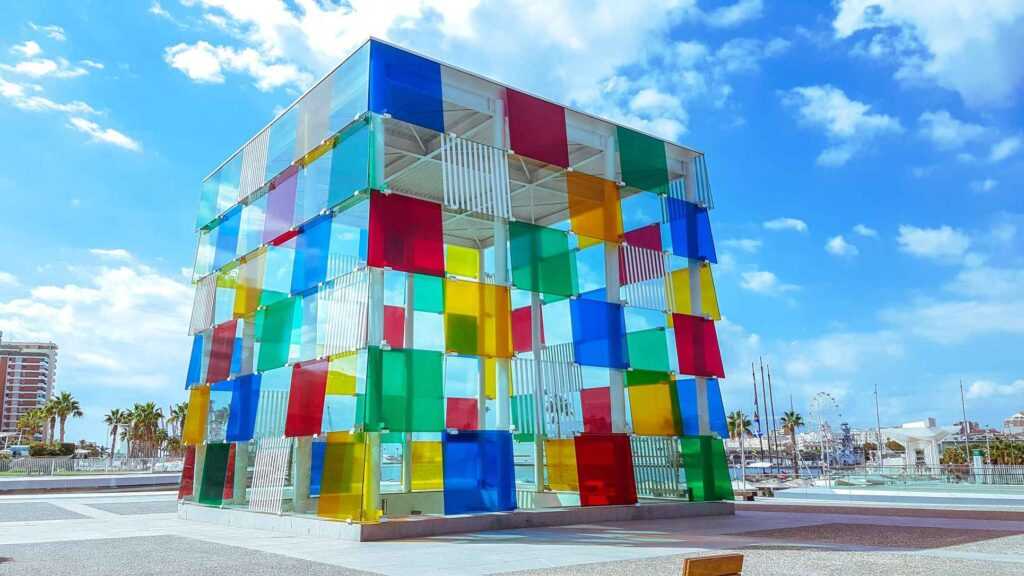
Malaga is known to be the cultural center of Andalucía and has about 30 museums. So, if you have time on your hands visit a museum or two during your time in the city.
- Picasso Birthplace Museum: The legendary artist was born there in 1881. You’ll learn more about his life and will see some of his personal belongings on display.
- Picasso Museum: Displays over 200 pieces of artwork by the famous artist.
- Carmen Thyssen Museum: This museum has an extensive collection of Spanish and Andalusian paintings.
- Automobile Museum Malaga
- Centre Pompidou Malaga
- Flamenco Art Museum
- Museo de Malaga
Day 6 – Ronda, Setenil de Las Bodegas and Cadiz
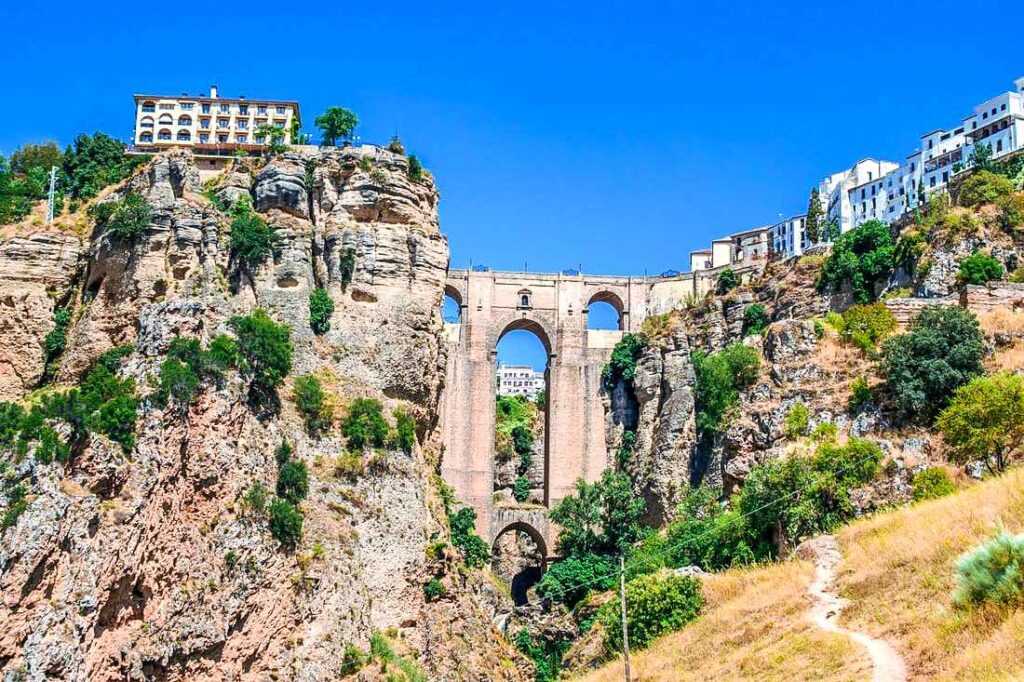
Time to say goodbye to the Costa del Sol and make your way to the beautiful village of Ronda, located an hour and 30 minutes away from Malaga.
The 5th stop on this Southern Spain Itinerary is known to be one of the most touristic places in Andalusia. Situated on a ridge, Ronda features stunning views, a gorge, an 18th-century bridge, and tranquil whitewashed streets. It’s the perfect place to spend half a day if you are short on time.
You can start by exploring a few of the best things to do in Ronda, such as marveling at Puerto Nuevo and visiting the Cuenca Gardens. Puente Nuevo is Ronda’s most famous landmark. This amazing stone bridge was built in 1788 and spans the gorge at its narrowest point, linking La Ciudad (the old Moorish part) with El Mercadillo (the 15th-century market area and ‘new’ town). The bridge is incredibly impressive and to get the best view you’ll need to cross the bridge and walk down the path of Camino de Los Molinos.
Walk through the historic town and then head to Puente Viejo (the old bridge) to visit the old Arab Baths. Well worth seeing as they date from the 12th century and are among the best-preserved in Spain.
If you choose to stay in Ronda and are around for sunset, there is no better place to be than admiring the views of Puerto Nuevo and the surrounding landscape from the Alameda del Tejo!
Note: Once you get to Ronda, there is plenty of parking in the streets before you get to the historic center.
Setenil de Las Bodegas
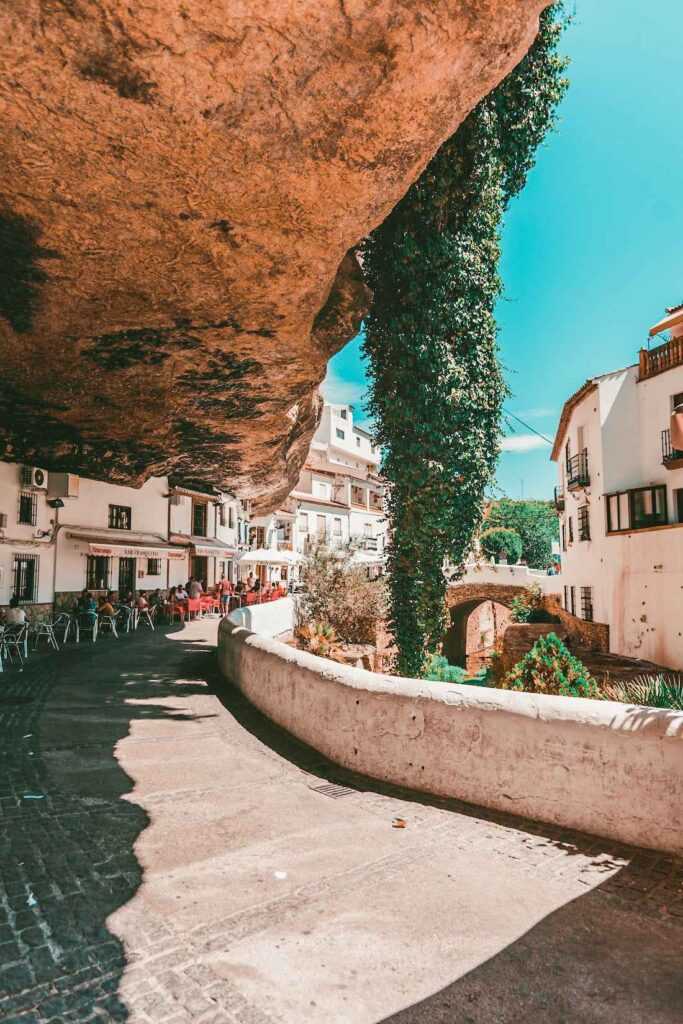
Driving from Ronda to Setenil de Las Bodegas will take around 20 minutes. This village is built in a rock. You won’t need more than an hour to explore. You can walk through the streets and check out the shops and restaurants that are built into the rock. It’s optional so if you are short on time I’d suggest leaving this off your itinerary.
Cadiz
Cadiz is one of the oldest cities in Western Europe that is visually stunning and historically fascinating. It’s almost surrounded by water and filled with history, beautiful beaches, and great restaurants.
The drive from Ronda is around 1 hour and 45 minutes. You’ll probably arrive in Cadiz in the evening so make yourself comfortable and head out to explore and enjoy the night scene of this amazing city.
Day 7 – Cadiz
Day 7 of the South of Spain road trip will be spent exploring Cadiz. Here are some of the top things to do in Cadiz:
- Cádiz Cathedral
- The Plaza de San Juan de Dios
- The Roman Theatre
- Tavira Tower
- The Castle of San Sebastian and the Castle of Santa Catalina.
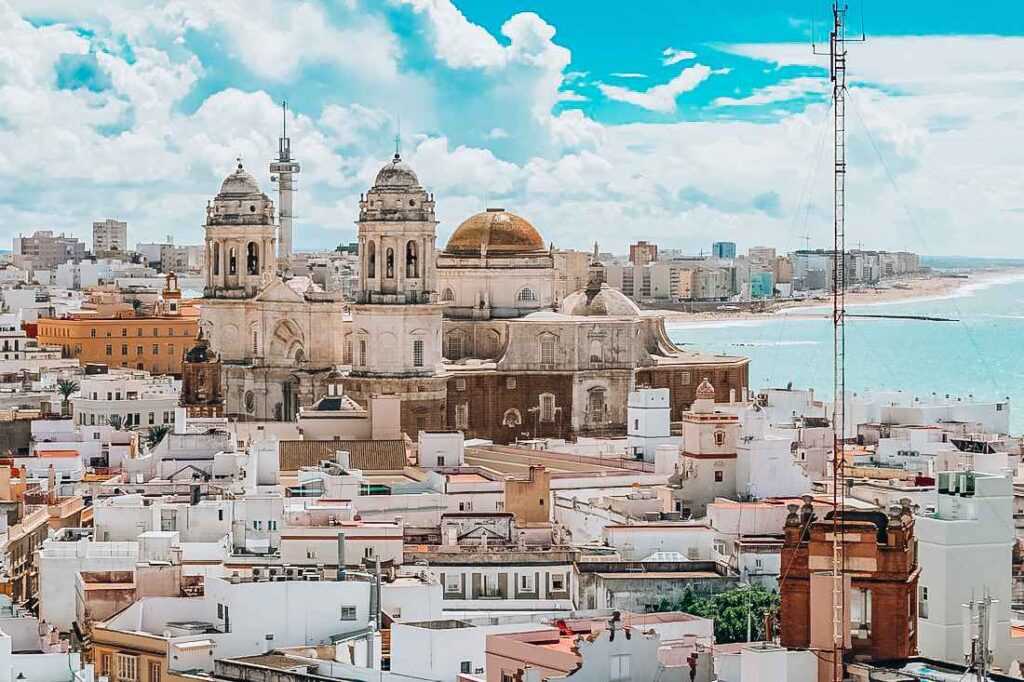
Cadiz is a hidden gem and one of the most beautiful coastal cities in Andalusia. You can start at the impressive cathedral which is the most prominent landmark here. Climb the tower for the best views of the city. Not far from the cathedral is the Roman Theatre.
From the cathedral, take a walk along the seaside on the Paseo del Vendaval towards the San Sebastian Castle and Castillo Santa Catalina.
You can then make your way to Cadiz Central Market to grab some lunch. You’ll find traditional dishes and local produce here. Don’t leave the market without trying tortillitas de Camarones (shrimp fritters).
Spend the rest of the day walking around Cadiz. Then relax at one of the beautiful beaches. You’ll need to give your feet a break from all the walking you’ve been doing in the past week.
If you are looking for a tour that covers Cadiz, Ronda, and Setenil de las Bodegas, you can find them here.
Day 8 – Jerez de la Frontera and Seville
Jerez de la Frontera is the perfect place to stop on the route to Seville. It’s about 30 minutes from Cadiz. As the sherry capital of Andalucia, you’ll have to make a pit stop to go on a sherry tour of some of Spain’s most famous bodegas.
With 20 churches, a cathedral, and an alcazar there’s no shortage of things to do in Jerez de la Frontera. Thankfully since Jerez de la Frontera is so small, it’s perfectly walkable and you’ll have no problems finding any of these attractions. If you happen to be there on a Sunday, you can stroll around the flea market right next to the Alcazar.
Grab a snack or an early lunch before you head back to the car to make your way to Seville. There are plenty of tapas bars and restaurants where you can find a very authentic experience.
Seville
Getting to Seville from Jerez de la Frontera takes only about an hour. Once you get to Seville, you’ll be mesmerized by how amazing this city is. It’s probably the most quintessential city in Spain and my favorite city during our time there.
Seville is the capital city and the heart and soul of Andalucía and has everything from culture, history, mouth-watering cuisine, bullfighting, and Flamenco! The city center is very walkable with a lot of the major attractions being close to each other.
Seville requires more than just one day to explore. You’ll spend time wandering through the narrow quaint streets in the historic center, visiting the cathedral and the all-famous Seville Alcazar. The best part is Seville is one of Spain’s finest cities when it comes to food. So, I’d highly recommend visiting a few tapas bars or even better taking a food tour or cooking class.
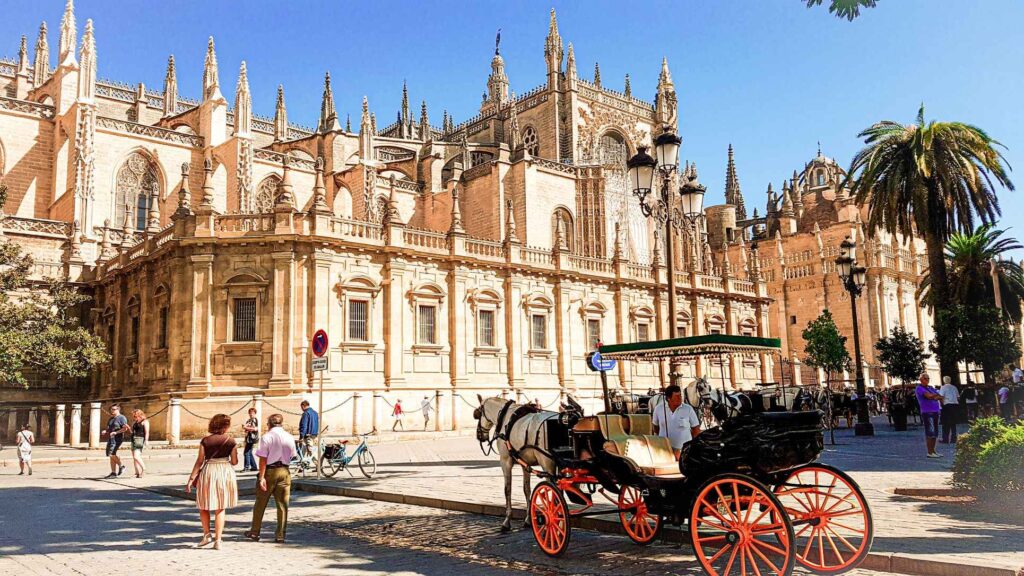
Here are some of the top attractions to visit in Seville:
- Visit Seville Cathedral and Giralda Tower
- Real Alcázar
- View Metropol Parasol
- Climb Torre del Oro for amazing views
- Walk through barrio de Santa Cruz
- Visit the amazing Plaza de España
- Take a stroll in the Maria Luisa Park
- Wander through the Triana neighborhood and indulge in some delicious tapas.
You’ll probably get into Seville late afternoon to early evening depending on how much time you spend in Jerez de la Frontera. So, I’d suggest on your first day take it easy and spend time walking around the historic center.
Start by making your way to the Metropol Parasol, a very peculiar-looking monument in Seville. This large wooden structure has the shape of a giant mushroom. You can climb to the top of the building and admire a 360-degree view of Seville.
After this head to the famous Seville cathedral which is about a 10-minute walk. The tomb of Christopher Columbus is found here. Climb the Giralda Tower and you’ll be rewarded with the best views of the city. Then finish off the night with a relaxing dinner and a Flamenco show.
Day 9 – Seville
Your second day in Seville will see you visiting some of the most popular attractions in the city. Have a big breakfast to prepare for a busy day ahead.
Real Alcázar
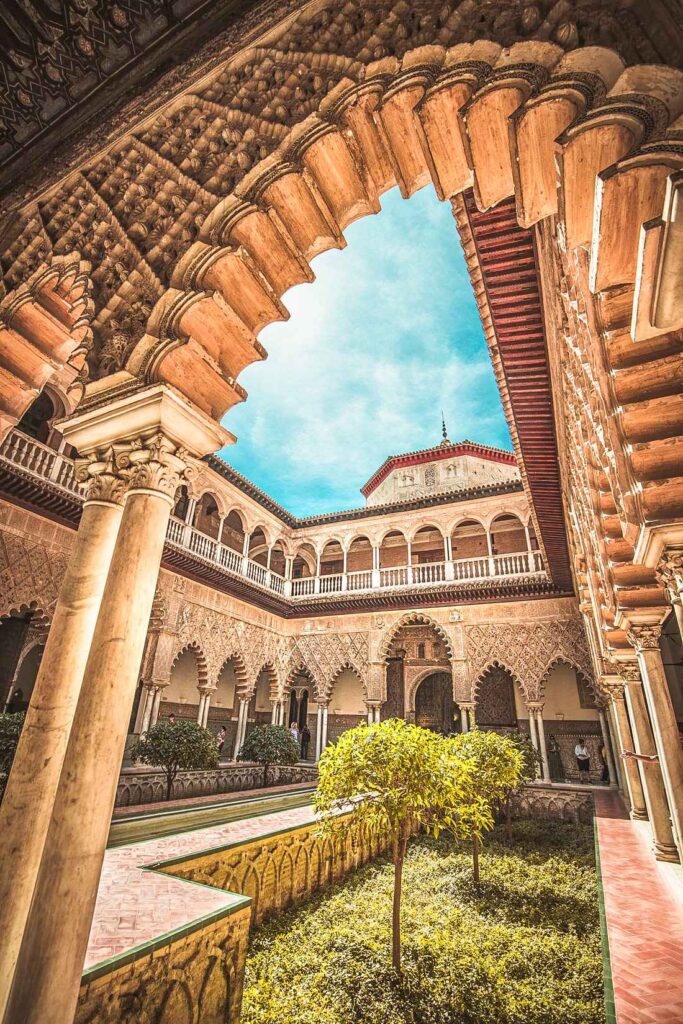
You’ll start your day bright and early with a visit to the Real Alcázar. If there’s one thing you should do in Seville, let it be this. It should be on your Southern Spain itinerary, and also on everyone’s bucket list.
This UNESCO World Heritage Site displays generations of history, from the Arabic period and Middle Ages to the Renaissance and Baroque periods. From the beautifully tiled rooms, the towers, and the immaculate gardens, the Real Alcázar is a feast for everyone’s eyes.
Top Tip: You should book these tickets well in advance of your arrival in Seville. There are two lines to enter the Alcázar – one for those buying tickets at the entrance, and another one for those who purchased them online. Both queues are very long, but the latter is always shorter. Book your tickets online in advance so that you can get in the shorter queue, but make sure to arrive 30-45 mins before opening hours regardless because even that queue is long! Alternatively, get the skip the line tickets, it’s well worth it!
River Guadalquivir and Torre del Oro
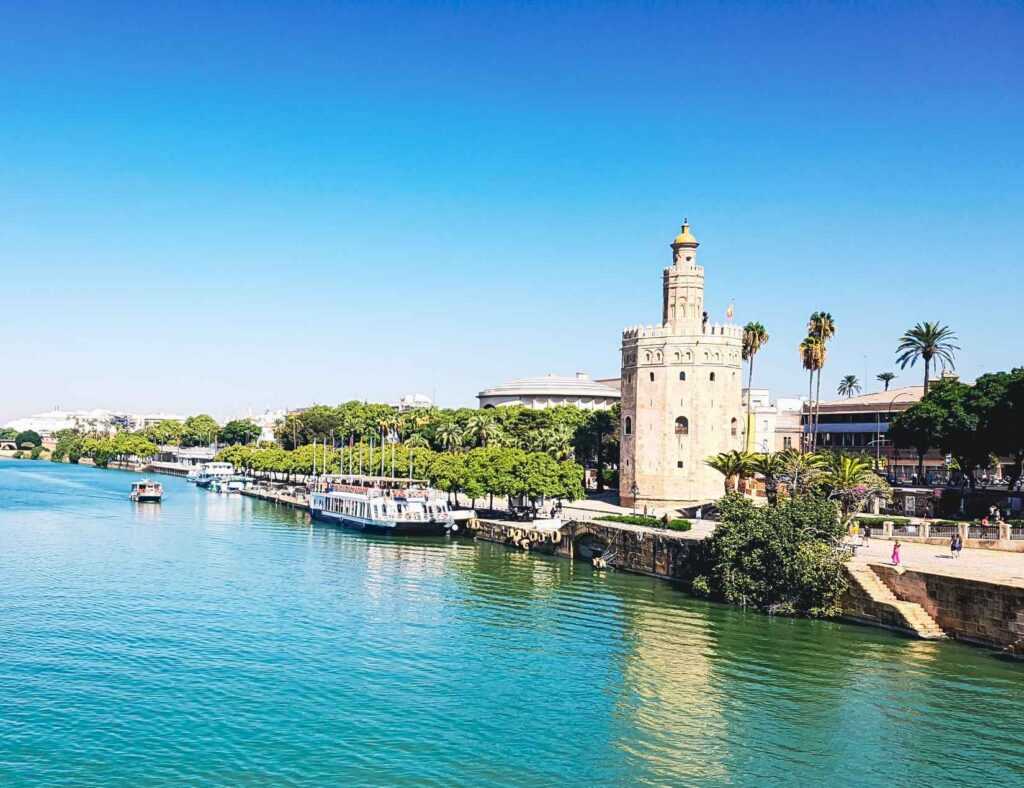
From the Alcázar make your way to Torre del Oro (less than a 10-minute walk) which is located right next to River Guadalquivir and was built to protect shipping and control access to Seville via the river. You can climb to the top of the tower where you’ll see flags, shipping instruments, and maps used back in the day. You’ll also get a nice view of the River from here.
Plaza De Toros De La Real Maestranza
Nearby to the Torre del Oro, Plaza de Toros de la Real Maestranza de Caballería is the oldest bullring in Spain. It has a capacity of 14,000 people making it one of the biggest in Spain. Have a quick wander around before heading to lunch.
Lunch: Head back towards the historic center where you’ll have plenty of options for food. You can always try Taberna del Arenal, a well-priced tapas bar. It’s about a 5-minute walk from the Alcázar.
Barrio Santa Cruz
After lunch stroll the colorful streets of Barrio Santa Cruz. Back in the 13th century, this neighborhood was known as the Jewish quarter. Today this neighborhood is filled with restaurants, and squares and is the perfect place to wander around aimlessly and really get a feel for what Seville has to offer.
Plaza de Espana
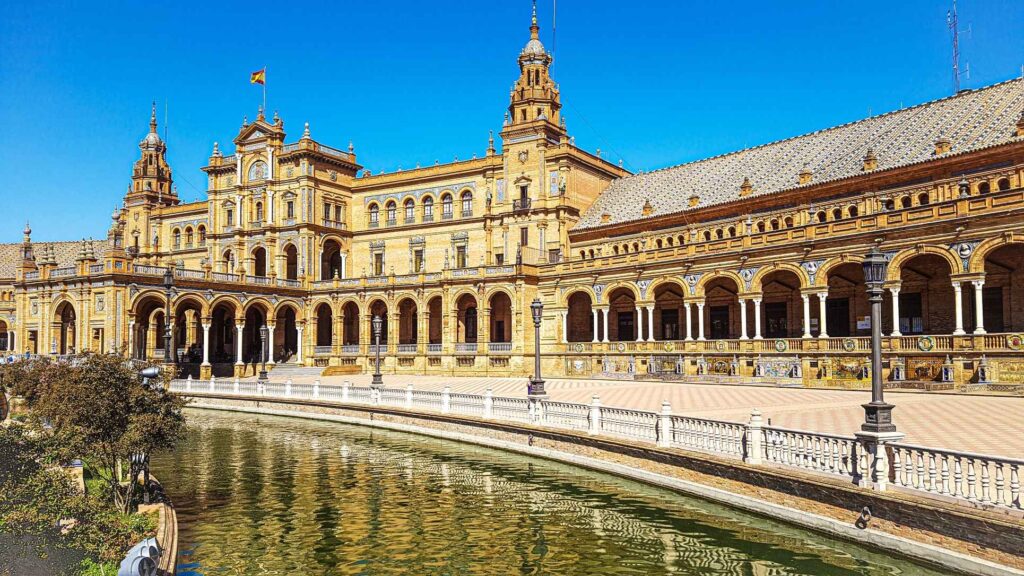
From Barrio Santa Cruz cut through Maria Luisa Park and make your way to the famous Plaza de Espana. This beautiful square has a gigantic semi-circular building that showcases a mixture of neo-Renaissance and neo-Moorish architectural styles. Today, it houses government offices.
This place is incredible and is one of the best places to visit in Seville. There’s a row of 48 stunning alcoves in this square decorated with intricate azulejos (traditional ceramic tiles used in Spain and Portugal). Each alcove depicts a different Spanish province, with a relevant fresco and a map.
In the middle of the square, you’ll find a beautiful canal where you can rent a boat and row around. This is why Plaza de Espana is also known as the “Venice of Seville”.
If you are looking to take some beautiful photos, this place provides some of the best photographic opportunities. However keep in mind if you want to get the place almost to yourself, you’ll need to make your way here first thing in the morning. Spend as much time as you’d like here before you make your way to your next stop
Triana
You’ll need to take a bus from Plaza de Espana to Triana. Unless you are feeling up to it, the walk is about 30 minutes.
Triana gives you an insight into the local life in Seville. Mercado de Triana is a great place to find local produce, all at a reasonable price. So, if you are staying in Seville for a week or more, you can always come here to grab your fresh produce. The locals are incredibly friendly and the best part is you can check out all the tapas bars here. You can easily grab some tapas or a coffee and pastry but not too many cause you’re headed to an authentic Spanish cooking class next.
This is your final destination for the day where you’ll learn to make authentic paella, gazpacho, and whatever else your heart desires. Just make sure you book with Taller Andaluz de Cocina well in advance and select the class you want to attend. We had a fabulous group of people from all over the world in our class. It was such a great culinary experience but also one where we met so many people traveling through Spain.
Day 10 – Cordoba
On the last day of your 10-day Southern Spain itinerary, you will head to Cordoba. You’ll spend the day exploring the magnificent city before making your way back to Seville for your final night. The drive from Seville to Cordoba takes approximately 1 hour 40 minutes. Alternatively, you can take the train which takes about 40 minutes. It’s the ideal day trip from Seville.
It’s possible to visit Córdoba in one day. You can cover all the main attractions in Córdoba as below:
- Start by visiting the Mosque-Cathedral of Córdoba, one of the most unique places in all of Spain.
- Then head to the Jewish Quarter and its flowery streets
- Visit the Alcázar of Córdoba and its magnificent gardens.
- Lunch at one of the Plazas
- Visit Plaza de la Corredera. Along the way you can see the Roman Temple of Córdoba.
- Walk along the Guadalquivir to get to the Bridge Gate and the Roman bridge of Córdoba
- Cross the bridge, and arrive at the Calahorra Tower
Mezquita
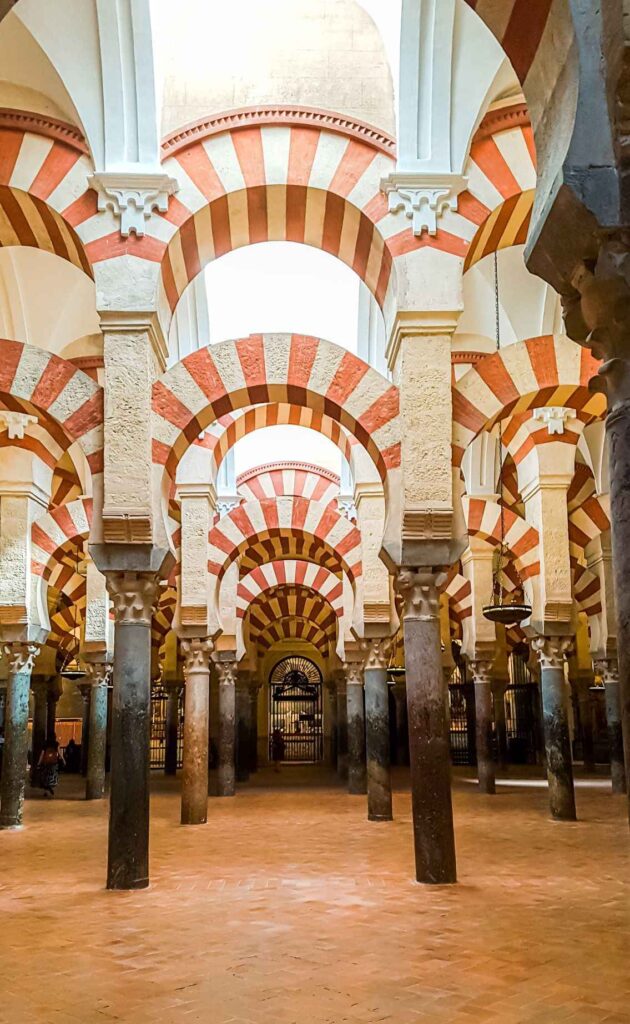
The final day of your Southern Spain itinerary is here. You’ll want to start your day as early as you can and head to Córdoba. The first thing you’ll do once you arrive in Córdoba is to make your way to the Mezquita, the Mosque-Cathedral of Córdoba. It’s one of Spain’s cultural wonders that was declared a World Heritage Site by UNESCO. The Mezquita is undoubtedly the most graceful, fascinating, and important attraction in Cordoba. In my opinion, it is one of the best things to do in Spain and one of the more unique places to visit in Spain.
Once the center of Muslim worship, the structure was converted into a cathedral making it a combination of a spectacular mosque and cathedral. The Mosque-Cathedral is open to the public and general ticket information can be found here. This is one of the most impressive monuments I’ve had the opportunity to see. The numerous red and white columns and arches contribute to the unique atmosphere. You can also climb the minaret of the Mezquita. It was roughly around 2€.
Note: If you plan to visit the Mosque-Cathedral, the Alcazar, and the Synagogue, you can always book a guided tour that includes all three attractions.
Jewish Quarter
After your Mezquita visit, head to the old town, or Jewish Quarter. This area was once a vibrant Jewish community from the 10th to the 15th century. It’s now the largest old town in Spain and a UNESCO World Heritage site that includes the majority of historical monuments to visit in Córdoba.
Stroll through the narrow streets with whitewashed houses that have signature hanging flower pots and colorful window box displays. Don’t miss La Calleja de las Flores, Cordoba’s most famous little alley, which leads to a nice view of Córdoba’s Mosque-Cathedral.
If time permits swing by the Synagogue, it’s the only existing synagogue in Andalusia and the third best preserved in Spain. Although small, it’s worth a visit.
Alcázar de los Reyes Cristianos
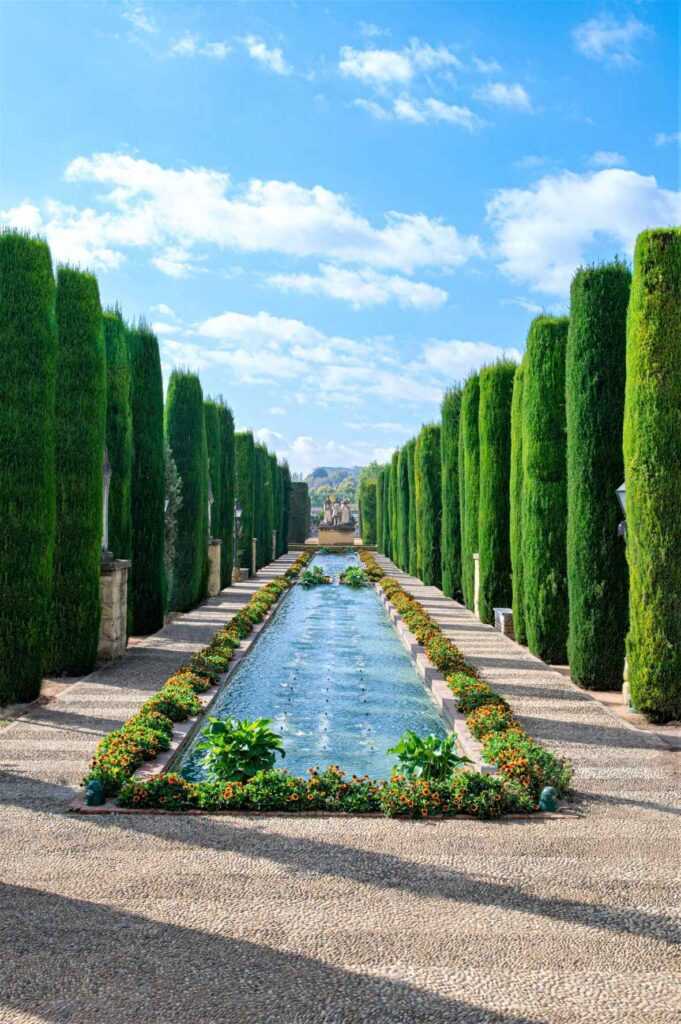
There’s a lot to discover here from gardens, courtyards, baths, and a large library, this royal compound has a long history. The gardens alone sprawl across 55,000 square meters!
You can visit one of Alcázar’s 4 towers and then make your way downstairs to visit the interior of the Alcázar of Córdoba, with its mosaic salon, the royal baths, and the Moorish patio. You can also enjoy the beautiful gardens that are lined with orange trees and fountains. If your feet need a bit of a break from the walking so far, you can relax in the gardens under some shade. It’s quiet and relaxing!
Archaeological Museum
The archaeological Museum is a hidden gem in Córdoba. It’s filled with archaeological remains and historic artifacts displaying years of Córdoba’s history. The main attraction is the remains of a Roman Theatre in its basement.
Roman Temple
The Roman Temple sits on a hill above the historic center right in front of the town hall. The marble temple was popularly known as the Temple of Claudio Marcelo. It has 11 monumental Corinthian columns. You can see the columns from the street as you walk by.
Plaza de la Corredera
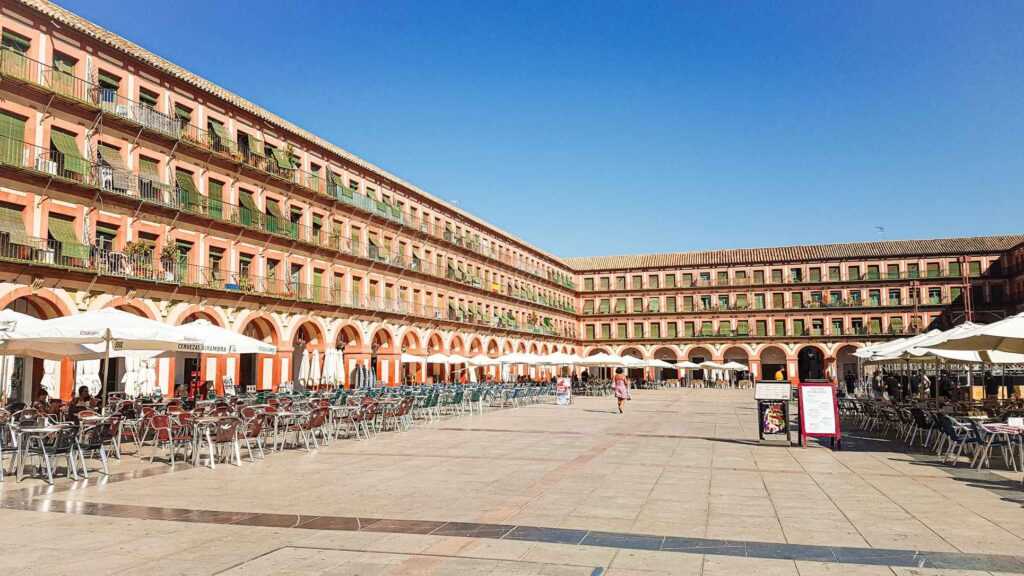
This plaza is located only about a minute from the Roman Temple and is one of the centers of daily life. It’s one of Córdoba’s most iconic squares with beautiful architecture. If you’ve been to Madrid, you’ll notice the square has a similar resemblance to that of Plaza Mayor in Madrid.
For many years the city’s bullfights were held right here and now you’ll find plenty of cafes, tapas bars, markets, and shops here. It’s the perfect place to give your feet a break and grab a coffee or drink.
Roman Bridge
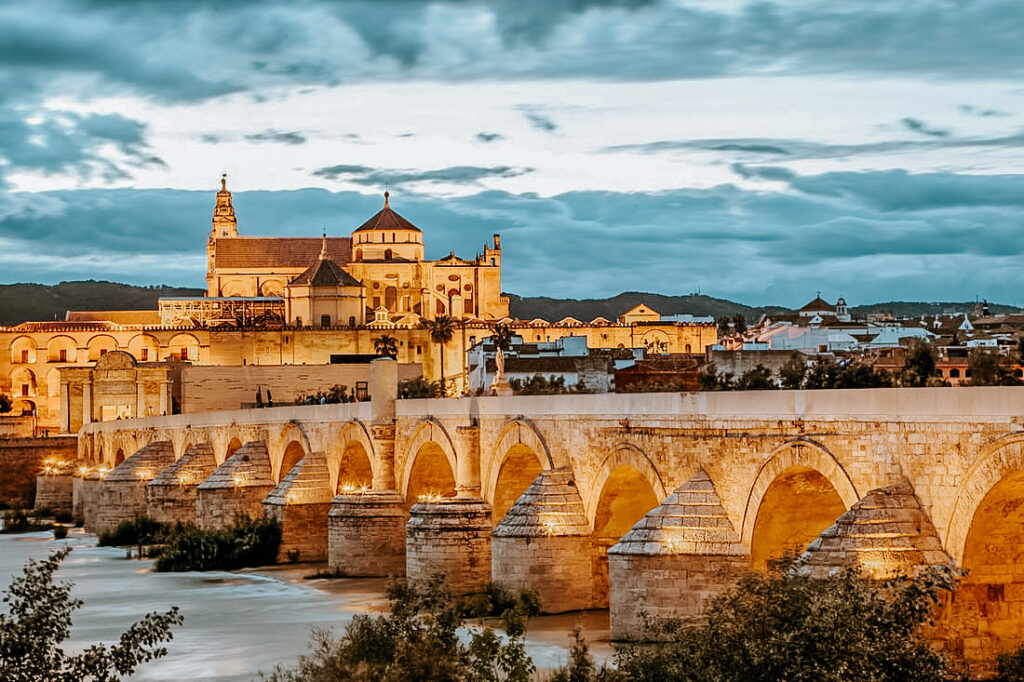
At the end of your day in Córdoba, stroll across the Roman Bridge. It’s one of those things every tourist must do in Córdoba. If you visit at sunset, you’ll see the stones of the bridge and the cityscape covered in an orange glow.
Built in the 1st century BC, it was the only bridge in the city for nearly 20 centuries and the main access to Córdoba. Crossing the bridge will take you directly to the Calahorra Tower. The stunning bridge is traffic-free and is part of Córdoba’s UNESCO classification. It’s a great place to take a leisurely stroll and feel the history of Córdoba.
Calahorra Tower
The Tower once served as a school and prison and now houses the Museum of Al-Andalus. You can also see a model of the mosque and access the tower’s terrace to enjoy the view of the bridge and river.
Patios de Córdoba
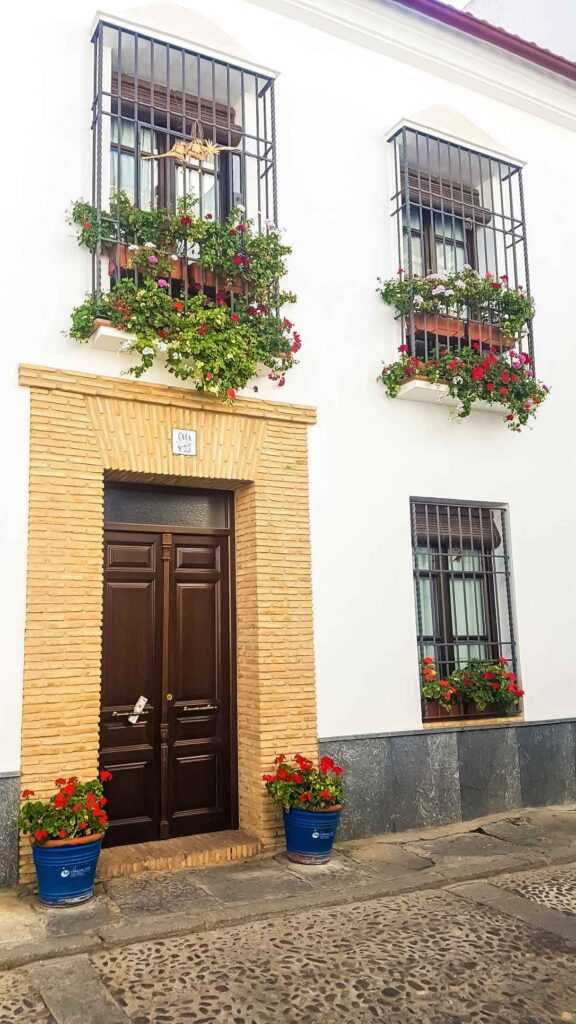
If you visit Córdoba in May, you’ll be welcomed to open courtyards that display the best flower arrangements and mosaics. The residents compete to make their courtyards the best in the city. It’s a great way to see a large number of courtyards that wouldn’t usually be open to tourists.
This is a busy day in Córdoba but one you’ll find well worth your time. You can also choose to stay in Córdoba for your last night. I’ve put the option to return to Seville as most people will need to fly out from a major city.
When you get back to Seville enjoy the evening taking in the atmosphere and indulging in some delicious tapas.
My best advice is to use this guide as a starting point but don’t be afraid to add some extra spots along the way or even take some off if you find it a bit too hectic. It all comes down to what you want to get out of your time in Southern Spain.
Things to know before you go to Southern Spain
Book Tickets in Advance
I cannot stress enough how much you need to book tickets to the Alhambra in Granada and the Alcázar in Seville well in advance. When I say well in advance, you’ll want to book tickets to the Alhambra as soon as you know you are heading to the region.
What to Eat in Southern Spain?
Southern Spain is heavily influenced by the Moors and you’ll see this everywhere in this region, especially in the food. The food in the Southern region of Spain is like no other. Delicious, hearty, and largely built on fresh and local produce. There are so many amazing dishes to try out in the South of Spain. But here are some of my top favorites you should try while traveling through this region. These are easily found in traditional Spanish bodegas, restaurants, or tapas bars.
Paella
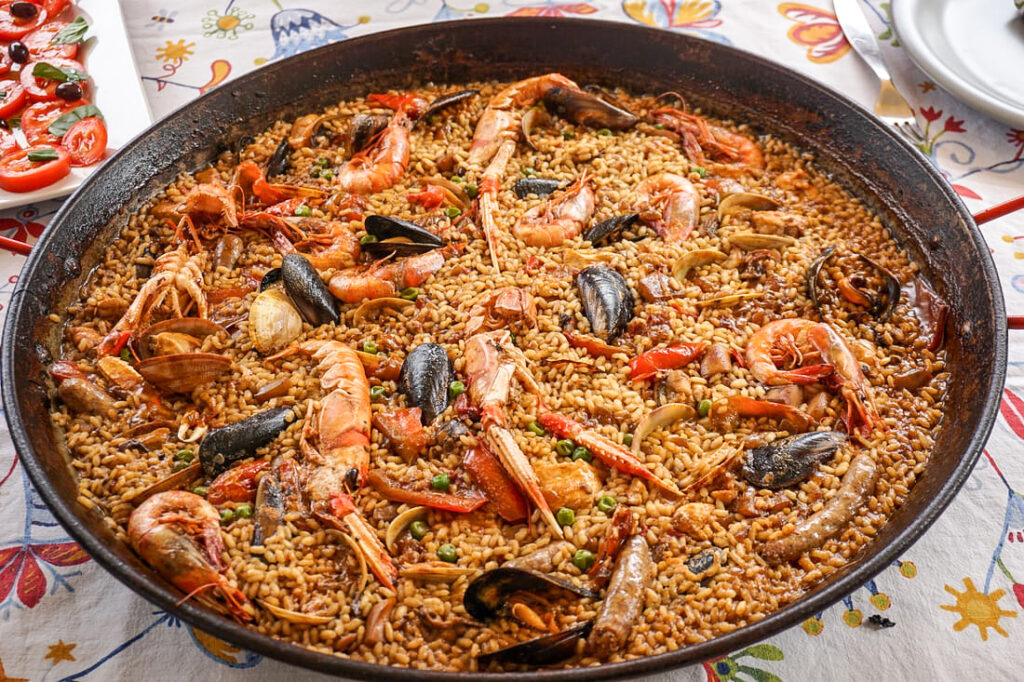
Even though Paella typically is from the Valencia region, the Paella in Seville just hits differently.
Jamon Ibérico
Iberian ham is found all over Spain. But the most exquisite, highest quality of ham comes from the Iberian pigs. So, the next time you are at a tapas bar in Southern Spain, be sure to get some Iberian ham. You can easily buy this in local supermarkets. Great to carry along for a picnic or serve as a side for breakfast.
Gazpacho or Salmorejo

Made well, it’s hard not to enjoy a bowl of this delicious cold soup on a hot summer’s day. Gazpacho is one of those things you’ll either like or dislike. It’s quite refreshing.
Gambas Pil Pil
If you like prawns, garlic and chili don’t skip this dish. I originally tried this in the Basque region, but it’s popularly found throughout the country.
Berenjenas con Miel
Crispy deep-fried eggplants with honey, simple yet so flavorful and delicious. An incredibly delicious dish.
Espetos
This is probably the most famous dish in Malaga. They are skewers of sardines grilled over a barbeque. You’ll commonly find them at most bars in Malaga, Marbella, and Nerja, especially those along the beach.
Chipirones
Fried baby squid is popularly found in this region. You need to get your hands on some.
Thick Hot Chocolate
This hot chocolate just hits differently. It’s thick, smooth, rich creamy, and undeniably delicious. Pair this with churros and you have a match made in heaven. This is one of the most popular things to do in Southern Spain.
Food tours are very popular in this region, so if you have the time I’d highly recommend doing one. We took a traditional Paella cooking class, where we also learned how to make Gazpacho. I couldn’t recommend the experience more. To date, we still make authentic Spanish Paella in our home in New Zealand.
Summary
Southern Spain offers a plethora of activities, historic sites, and pristine world-class beaches. Whether you’re looking to catch a flamenco show, indulge in the fine cuisine the region has to offer, or simply relax at the beach, Southern Spain has plenty of things to do and see and something to offer everyone. It is the absolute epitome of Spanish culture!
If you have only 10 days in Southern Spain, you’ll see this itinerary covers some of the best places to visit in the South of Spain. While the itinerary is fast-paced, it makes the most of your time in the region and gives you a taste of what Southern Spain has to offer.
While I’m all about slow travel and immersing yourself in a place, to learn about its culture, people, and food, I understand that not everyone can afford the luxury of time. So, I’ve used my knowledge and experience from traveling around this region and summarised it into a 10-day Southern Spain itinerary. This itinerary covers some of the best places to visit in Andalusia and is the minimum amount of time I recommend to explore the beautiful Andalusian region. With so much to offer, you’ll be kicking yourself for more time in this region.
Happy Travels!
Note: The information here is updated the best we can at the time of writing this article. Please check attractions, activities, and transport before you can as things tend to change from time to time.
More on Spain
- 26 Top Tourist Attractions in Spain
- 20 Best Things To Do in Barcelona, Spain
- Best Neighborhoods in Barcelona
- A Day Trip from Barcelona to Montserrat
- 3 days in Barcelona



